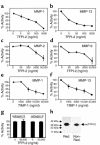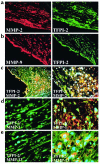Tissue factor pathway inhibitor-2 is a novel inhibitor of matrix metalloproteinases with implications for atherosclerosis
- PMID: 11342575
- PMCID: PMC209273
- DOI: 10.1172/JCI10403
Tissue factor pathway inhibitor-2 is a novel inhibitor of matrix metalloproteinases with implications for atherosclerosis
Abstract
Degradation of ECM, particularly interstitial collagen, promotes plaque instability, rendering atheroma prone to rupture. Previous studies implicated matrix metalloproteinases (MMPs) in these processes, suggesting that dysregulated MMP activity, probably due to imbalance with endogenous inhibitors, promotes complications of atherosclerosis. We report here that the serine proteinase inhibitor tissue factor pathway inhibitor-2 (TFPI-2) can function as an MMP inhibitor. TFPI-2 diminished the ability of the interstitial collagenases MMP-1 and MMP-13 to degrade triple-helical collagen, the primary load-bearing molecule of the ECM within human atheroma. In addition, TFPI-2 also reduced the activity of the gelatinases MMP-2 and MMP-9. In contrast to the "classical" tissue inhibitors of MMPs (TIMPs), TFPI-2 expression in situ correlated inversely with MMP levels in human atheroma. TFPI-2 colocalized primarily with smooth muscle cells in the normal media as well as the plaque's fibrous cap. Conversely, the macrophage-enriched shoulder region, the prototypical site of matrix degradation and plaque rupture, stained only weakly for TFPI-2 but intensely for gelatinases and interstitial collagenases. Evidently, human mononuclear phagocytes, an abundant source of MMPs within human atheroma, lost their ability to express this inhibitor during differentiation in vitro. These findings establish a new, anti-inflammatory function of TFPI-2 of potential pathophysiological significance for human diseases, including atherosclerosis.
Figures






Similar articles
-
Increased expression of matrix metalloproteinases and matrix degrading activity in vulnerable regions of human atherosclerotic plaques.J Clin Invest. 1994 Dec;94(6):2493-503. doi: 10.1172/JCI117619. J Clin Invest. 1994. PMID: 7989608 Free PMC article.
-
Expression of neutrophil collagenase (matrix metalloproteinase-8) in human atheroma: a novel collagenolytic pathway suggested by transcriptional profiling.Circulation. 2001 Oct 16;104(16):1899-904. doi: 10.1161/hc4101.097419. Circulation. 2001. PMID: 11602491
-
Human monocyte-derived macrophages induce collagen breakdown in fibrous caps of atherosclerotic plaques. Potential role of matrix-degrading metalloproteinases and implications for plaque rupture.Circulation. 1995 Sep 15;92(6):1565-9. Circulation. 1995. PMID: 7664441
-
Matrix metalloproteinases: influence on smooth muscle cells and atherosclerotic plaque stability.Expert Rev Cardiovasc Ther. 2007 Mar;5(2):265-82. doi: 10.1586/14779072.5.2.265. Expert Rev Cardiovasc Ther. 2007. PMID: 17338671 Review.
-
Vascular extracellular matrix in atherosclerosis.Cardiol Rev. 2013 Nov-Dec;21(6):270-88. doi: 10.1097/CRD.0b013e31828c5ced. Cardiol Rev. 2013. PMID: 23422022 Review.
Cited by
-
Atrial extracellular matrix remodelling in patients with atrial fibrillation.J Cell Mol Med. 2008 Jan-Feb;12(1):189-208. doi: 10.1111/j.1582-4934.2008.00219.x. Epub 2008 Jan 10. J Cell Mol Med. 2008. PMID: 18194448 Free PMC article.
-
Reduced expression of tissue factor pathway inhibitor-2 contributes to apoptosis and angiogenesis in cervical cancer.J Exp Clin Cancer Res. 2012 Jan 2;31(1):1. doi: 10.1186/1756-9966-31-1. J Exp Clin Cancer Res. 2012. PMID: 22208663 Free PMC article.
-
Induction of Tissue Factor Pathway Inhibitor 2 by hCG Regulates Periovulatory Gene Expression and Plasmin Activity.Endocrinology. 2017 Jan 1;158(1):109-120. doi: 10.1210/en.2016-1544. Endocrinology. 2017. PMID: 27813674 Free PMC article.
-
High matrix metalloproteinase production correlates with immune activation and leukocyte migration in leprosy reactional lesions.Infect Immun. 2010 Mar;78(3):1012-21. doi: 10.1128/IAI.00896-09. Epub 2009 Dec 14. Infect Immun. 2010. PMID: 20008541 Free PMC article.
-
Deficiency of cathepsin S reduces atherosclerosis in LDL receptor-deficient mice.J Clin Invest. 2003 Mar;111(6):897-906. doi: 10.1172/JCI14915. J Clin Invest. 2003. PMID: 12639996 Free PMC article.
References
-
- Petersen LC, et al. Inhibitory properties of a novel human Kunitz-type protease inhibitor homologous to tissue factor pathway inhibitor. Biochemistry. 1996;35:266–272. - PubMed
-
- Butzow R, Huhtala ML, Bohn H, Virtanen I, Seppala M. Purification and characterization of placental protein 5. Biochem Biophys Res Commun. 1988;150:483–490. - PubMed
-
- Iino M, Foster DC, Kisiel W. Quantification and characterization of human endothelial cell-derived tissue factor pathway inhibitor-2. Arterioscler Thromb Vasc Biol. 1998;18:40–46. - PubMed
-
- Rao CN, Mohanam S, Puppala A, Rao JS. Regulation of ProMMP-1 and ProMMP-3 activation by tissue factor pathway inhibitor-2/matrix-associated serine protease inhibitor. Biochem Biophys Res Commun. 1999;255:94–98. - PubMed
Publication types
MeSH terms
Substances
Grants and funding
LinkOut - more resources
Full Text Sources
Other Literature Sources
Miscellaneous

